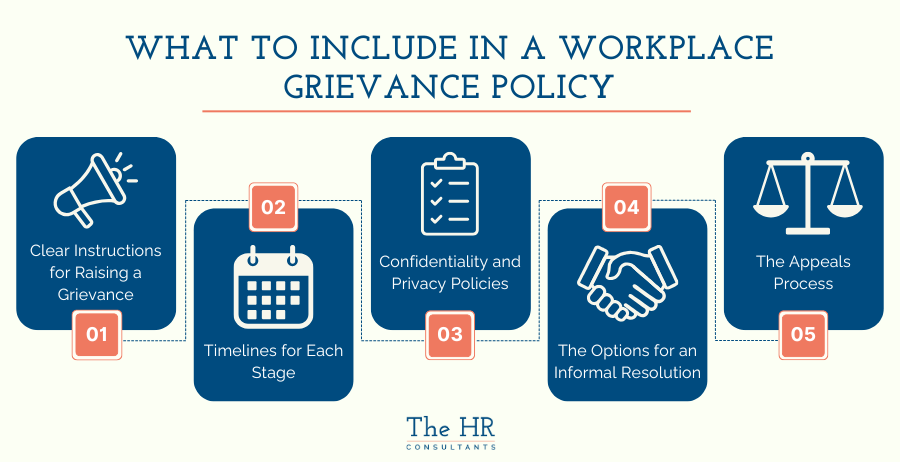Handling a grievance at work can be overwhelming, but understanding the process can help keep things as straightforward and fair as possible. At The HR Consultants, we bring over 20 years in taking the stress out of HR and we're here to walk you through how to handle a grievance at work professionally. Whether you're an employee or employer, we've got your back!
Table of Contents
- What is a Grievance at Work?
- Examples of Grievances at Work
- What to Include in a Workplace Grievance Policy
- Formal Grievance Procedures for Employees
- How to Handle Grievances at Work as an Employer
- Mediation and Alternative Dispute Resolution
- What Happens if a Grievance Cannot Be Resolved?
- Settlement Agreements Following Grievances
- Taking The Pressure Off: The HR Consultants
- Frequently Asked Questions
What is a Grievance at Work?
A grievance at work is when an employee makes a formal complaint in writing regarding something that is making them unhappy at work. Whilst this usually follows an informal complaint, it doesn't necessarily have to.
As the Advisory, Conciliation and Arbitration Service (ACAS) puts it in their official guidance to formal grievances:
The employee can raise a grievance if:
- they feel raising it informally has not worked
- they do not want it dealt with informally
- it's a very serious issue, for example sexual harassment or whistleblowing
Why is a Grievance Procedure Important?
Having a fair grievance procedure is important because it gives employees confidence that their concerns will be taken seriously and handled properly. Without one, it’s easy for workplace morale to take a hit or for issues to go unresolved.
A good process ensures that both employees and employers know what to expect, creating a more positive and supportive work environment for everyone.

Examples of Grievances at Work
Let’s look at some common types of grievances and how they can be resolved.
Pay and Benefits Disputes
- Example: An employee notices their payslip doesn’t include the overtime they have worked for the last few months.
- How it is resolved: A meeting is arranged to discuss the issue, and the manager checks payroll records and confirms the mistake. The missing overtime pay is added to the next payslip, and the manager explains how the error happened. They agree on the resolution that overtime will be tracked with a new and improved system.
Changes to Terms of Employment
- Example: A company implements a new rota requiring staff to work additional weekend hours, which wasn’t part of the original employment contract. An employee finds this difficult due to family commitments.
- How it is resolved: The manager arranges a meeting to understand their concerns. Together, they agree on a flexible solution where the employee can swap weekend shifts with colleagues. The company also commits to giving more notice for future changes to work patterns.
Discrimination and Unequal Treatment
- Example: An employee feels they are being overlooked for promotions in favour of less qualified colleagues, suspecting the decision is influenced by their ethnicity.
- How it is resolved: HR identifies gaps in the promotion process that suggest unconscious bias is playing a role. The company revises the process to make it more transparent and introduces diversity and inclusion training for managers. The employee is reassured that they will receive fair consideration for future opportunities.
Bullying and Harassment
- Example: A team member feels targeted by a colleague who makes unfair comments about their work during meetings and excludes them from group discussions.
- How it is resolved: Interviews with both parties and team members confirm the bullying behaviour. The colleague is required to attend training on communication and workplace behaviour. Mediation sessions are agreed to help rebuild the working relationship, and HR schedules follow-ups to ensure the issue doesn’t persist.
Health and Safety Concerns
- Example: An employee notices a piece of equipment in the warehouse is faulty and poses a risk of injury.
- How it is resolved: The employee immediately raises the concern with their manager, who removes the equipment from use and arranges for a health and safety inspection. As the manager acted quickly in this scenario, a full grievance procedure could be avoided.
Poor Management Practices
- Example: An employee feels unsupported by their manager, who gives unclear instructions and rarely provides feedback, leaving them unsure about their performance.
- How it is resolved: Following a grievance meeting, HR offers the manager additional training in leadership and communication. Regular one-to-one meetings are also agreed as a resolution to the issue, giving team members a chance to discuss their progress and receive constructive feedback.

What to Include in a Workplace Grievance Policy
Every workplace should have a grievance policy—it’s like a safety net for employees and employers alike. It lays out the steps for raising and handling grievances and ensures everything is done consistently and fairly. These procedures must use the Acas Code of Practice as a baseline.
Here’s what your policy should include:
1. Clear Instructions for Raising a Grievance
Employees need to know how to start the process. Your policy should explain:
- Who to contact: Make it clear who they should approach, whether it’s their manager, HR, or someone else. If the grievance involves their direct manager, provide an alternative point of contact.
- How to do it: Specify how grievances should be raised, e.g. via an email or physical letter. Providing a template can help employees feel more confident about structuring their concerns.
- What to expect next: Reassure employees that their grievance will be acknowledged promptly and explain what the next steps will involve.
2. Timelines for Each Stage
Setting expectations around timing helps everyone involved stay on track. Your policy should outline:
- How quickly grievances will be acknowledged (e.g., within 5 working days).
- How long it might take to arrange meetings and investigate the grievance.
- When the employee can expect a decision.
3. Confidentiality and Privacy Policies
Reassure employees that their grievance will be treated with sensitivity. This includes:
- Who will have access: Only those directly involved in the process.
- How records are kept: Let employees know how their information will be stored securely, in line with the Data Protection Act.
4. The Options for an Informal Resolution
Not every issue needs to go through a formal process. Sometimes, sitting down and having an honest conversation can resolve things more quickly. Your policy should encourage employees to consider informal options first and explain when this might be appropriate.
5. The Appeals Process
If an employee isn’t satisfied with the grievance outcome, they should know how to appeal. Your policy should explain:
- How to submit an appeal, including who to contact and the timeframe for doing so.
- What happens during an appeal (e.g., a review by someone not involved in the original grievance).

Formal Grievance Procedures for Employees
If you're an employee and informal chats don’t resolve the issue or the problem is too serious to handle casually, it’s time to move on to a formal grievance procedure. Here's what that looks like for you as an employee.
Writing a Formal Grievance Letter
The first step in the formal grievance process is submitting a grievance letter. Your employer's grievance procedure should outline how to do this.
You should make sure that your letter:
- Clearly outlines what happened, including key details like dates, times, and who was involved.
- Highlights how the issue is affecting your work or well-being and any previous efforts that have been taken to resolve it.
- Includes any evidence, e.g. payslips or contracts (this is optional).
- Requests a meeting and proposes a resolution if you have an idea of how the issue could be resolved.
- Clarifies if you would like to be accompanied to the grievance meeting. You’re entitled to bring a colleague, certified trade union representative, or official from a trade union to support you.
Meeting with the Employer
Once your grievance is received, your employer will arrange a formal meeting to discuss it. Here’s how to make the most of the meeting:
- Bring any relevant documents or notes to support your grievance. Think about what you want to say and write it down beforehand to stay organised.
- If you’re unsure about something, don’t hesitate to ask for clarification.
Appealing the Employer’s Decision
If the outcome of the grievance isn’t what you hoped for or you feel the process wasn’t handled fairly, you have the right to appeal. Here’s how to approach an appeal:
- Most organisations set a deadline for appeals, usually within 5–10 working days of receiving the decision.
- Clearly explain why you’re appealing. This could be because you believe it wasn't a fair procedure, the procedure wasn’t followed, or new evidence has come to light.
- Be clear about what outcome you’re hoping for.

How to Handle Grievances at Work as an Employer
Handling grievances fairly and professionally is essential for maintaining trust and transparency in the workplace. The Acas guidance provides a clear framework for managing formal grievances step-by-step for you as an employer.
Responding to a Formal Grievance
The first thing you need to do when an employee raises a written grievance is acknowledge it and let them know what’s going to happen next.
- Acknowledge the grievance: Write back to the employee confirming you’ve received their grievance. Let them know the next steps and give them a rough idea of the timeline so they know what to expect.
- Review the grievance: Take time to carefully read what they’ve raised. Think about who will handle the issue—ideally, someone impartial—and decide if it can be resolved informally before moving into a formal meeting.
- Prepare for the meeting: Schedule a time and place for the grievance meeting that’s convenient and private. This should be 'without unreasonable delay' and ideally within 5 days. Let the employee know they can bring a companion, like a colleague, union representative, or an official employed by a trade union, to support them—this is a statutory right.
- Consider whether adjustments are necessary: If the employee is disabled, consider whether there is a need for reasonable adjustments, such as changing the place of the meeting. If the employee does not speak English fluently, an interpreter should be arranged.
The Grievance Meeting
The grievance meeting is a formal procedure where the employee gets to fully explain their concerns, and you get the chance to listen and ask questions.
- Keeping an open mind: Go into the meeting ready to listen. Even if you think you know what’s going on, give the employee space to explain in their own words and provide evidence. You should discuss with the employee how the issue should be resolved.
- Asking questions: If something isn’t clear, don’t hesitate to ask for more details or examples. This helps you get a full picture of the situation. The employee should also be invited to ask questions and explain how they feel.
- Staying professional: Even if emotions run high, remain calm and respectful. It's important for you to stay impartial.
- Going through the evidence: Carefully review the evidence and decide if there's a need to investigate further. You won't usually need to make an immediate decision, unless the case calls for it.
- Taking notes: Write down the key points so you can refer back to them later. It also shows the employee you’re paying attention. Another person can also be appointed to do this, as well as act as a witness of the meeting, if necessary.
- Before ending the meeting: Sum up the main points and give the employee a copy of the notes and meeting record. You should also ask them to confirm that the notes are accurate, and let them know when they'll get a decision.
Deciding the Outcome
Once the meeting is over, it’s time to decide how to handle the grievance.
- Review and investigate: Go over the notes from the meeting, along with any documents or evidence the employee provided. If needed, you can investigate further to find out more information. Look at relevant policies or guidelines to help you make a fair decision, and refer to what the organisation has done in any similar past cases.
- Check on compliance: If you are sharing any information provided by the employee, you'll need to get their permission under the Data Protection Act. This information can be made anonymous before it's shared if requested.
- Decide on the action: Depending on the grievance, this could mean resolving the issue, offering mediation, or (in some cases) a disciplinary procedure. You can set up a second meeting once you have found out more information if you feel this is needed.
- Communicate clearly: Write to the employee explaining your decision and the reasoning behind it. If the grievance isn’t upheld, let them know why and explain their right to appeal if they’re not satisfied, or feel the grievance procedure was wrong or unfair.
After The Grievance
The grievance should remain confidential once it is finished, however, Acas recommends privately speaking with anyone involved (where appropriate). This can be to let them know that the process is finished, inform them about any changes that might be introduced as a result of the grievance, and remind them that they should not discuss the process with colleagues.

Mediation and Alternative Dispute Resolution
Sometimes, it helps to bring in a neutral third party to mediate disputes. Mediation can be a great way to resolve conflicts without the stress of formal disciplinary and grievance procedures.
What is Mediation?
Mediation involves a trained, impartial mediator who helps both parties discuss their issues and find a resolution. It’s voluntary, confidential, and focuses on finding common ground.
Mediation works well for issues like communication problems, workplace conflicts, or misunderstandings and is less commonly used for issues regarding pay or conduct. For example, if two colleagues are struggling to work together, a mediator can help them address the root of the issue and agree on ways to move forward.
Here's when to consider using mediation:
- Early intervention: Mediation is most effective when used early, before issues escalate.
- When relationships matter: If you need to maintain a good working relationship, mediation can help rebuild trust.
- For informal resolution: It’s a less formal and stressful alternative to grievance procedures.

What Happens if a Grievance Cannot Be Resolved?
If you're an employee and you're not satisfied with the grievance process, including any appeals, there are more steps you can take. For serious issues like discrimination or regularly being paid below your wages, there is the option of taking your case to an employment tribunal.
Before doing so, you’ll need to notify Acas and start the Early Conciliation process, which aims to resolve disputes without going to court. In the majority of cases, you'll need to do this within 3 months (minus one day) from the day that the incident at work occurred.
You can also claim constructive dismissal through an employment tribunal if you believe there has been a fundamental breach of their employment contract that has forced you to resign.
However, this is typically a last resort, and many issues can be resolved internally through clear communication and fair processes. If these processes haven't worked, a settlement agreement is typically a better way forward than constructive dismissal.
Settlement Agreements Following Grievances
In some cases, particularly if the grievance involves ongoing issues that can’t be resolved, a settlement agreement might be the best option.
What is a Settlement Agreement?
A settlement agreement is a legally binding document. It usually involves the employee and employer agreeing to part ways on certain terms, often involving compensation or a reference.
When to Consider a Settlement Agreement
Both parties should seek independent legal advice before signing a settlement agreement to ensure it’s fair. Here are some scenarios in which you might consider one:
- When all prior action has been taken: If the employer and employee have worked to solve the problem but continuing to work together isn’t feasible, a settlement agreement can provide closure for both parties.
- To avoid legal action: It’s a way to resolve disputes without going through tribunal proceedings. Settlement agreements can include the term that the employee cannot raise a tribunal claim. These are completely voluntary to enter into, so employees have the choice of whether to agree to this or not.

Taking The Pressure Off: The HR Consultants
At The HR Consultants, we understand how important it is to balance the needs of your employees while protecting your business. That’s why we’re here to guide you every step of the way—whether you need help creating a solid grievance procedure, handling a specific issue, or making sure your processes meet all the legal requirements.
Our approach is always impartial, keeping everything fair for employers and employees. We’ll take the pressure off, helping you make informed decisions that resolve issues quickly while maintaining trust in your workplace.
Ready to handle workplace grievances with confidence? Let us take the weight off your shoulders!
[addCTA blink=""/services/hr-outsourcing-services/"" title=""Explore our professional HR outsourcing services""]

Frequently Asked Questions
We've answered some of the most common questions on raising a grievance at work below.
What constitutes a grievance at work?
Any formal complaint made by an employee about an issue affecting their job or workplace experience can constitute as a grievance at work. This could include problems like bullying, discrimination, unfair pay, or health and safety concerns.
Is it worth raising a grievance at work?
It’s worth raising a grievance at work if the issue is impacting your ability to do your job, your well-being, or your overall experience. However, it’s often a good idea to try addressing the issue informally first, as many problems can be resolved through open and honest conversations. If that doesn’t work, a formal grievance ensures the matter is taken seriously.
What happens when someone puts in a grievance about you at work?
When someone raises a grievance about you, your employer will usually start by informing you of the complaint. They may arrange a meeting to hear your side of the story and investigate the matter fairly. It’s important to stay calm and cooperative throughout the process, as this ensures it’s handled professionally and gives you the best opportunity to explain your perspective.












